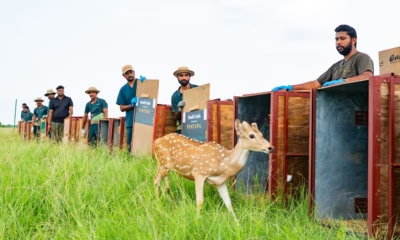Earth
A New dawn for three African elephants: From Tunisia to compassionate care at ‘Vantara’
Achtaum, the male of the group, has a split tusk and a molar tooth infection, requiring immediate and ongoing medical intervention

In a heart-wrenching journey spanning continents, three African elephants will soon embark on a transformative path to healing and freedom. Vantara, a world-renowned wildlife sanctuary in India, will soon welcome Achtaum, Kani, and Mina—a trio of African forest elephants who have spent nearly 23 years under the harsh, confining conditions of a private zoo in Tunisia. For these majestic creatures, a new life of care and compassion awaits.
In a powerful act of compassion and responsibility, Vantara (Star of the Forest), one of the world’s leading wildlife rescue centers, is preparing to receive three African forest elephants from the arid confines of Tunisia. These elephants—Achtaum, Kani, and Mina—are between 28 and 29 years old, and their lives have been anything but ordinary. For two decades, they have lived in Friguia Park, a private zoo in Tunisia, where they were brought from Burkina Faso as young calves. What began as a hopeful chapter for these elephants has, over the years, become a story of neglect and financial hardship.
Friguia Park, once an attraction for visitors seeking a glimpse of these majestic creatures, faced mounting financial challenges that left it unable to meet the elephants’ complex and ever-evolving needs. The zoo, with limited resources, struggled to provide the elephants with the care they desperately required—especially in terms of their specialized diet, healthcare, and proper living conditions. The decision was made: the elephants could no longer stay in Tunisia, but a return to the wild, where they could reclaim their rightful place, was not an option. Instead, the zoo sought out Vantara. Founded by Anant Mukesh Ambani, Vantara has become a sanctuary of healing for wildlife from around the globe.
Founded by Anant Mukesh Ambani, Vantara has become a sanctuary of healing for wildlife from around the globe
Despite being the stars of Friguia Park for many years, life at adverse conditions had taken a toll on Achtaum, Kani, and Mina. A recent veterinary assessment conducted by Vantara’s team revealed startling health concerns. They have become vulnerable to a range of conditions: skin ailments, malnourishment, and poor physical health. Achtaum, the male of the group, has a split tusk and a molar tooth infection, requiring immediate and ongoing medical intervention. Kani, one of the females, has cracked nails—likely due to prolonged exposure to hard, unnatural flooring. Their living quarters were little more than poorly ventilated concrete cells, with limited access to natural elements like fresh water, green forage, or the essential mental stimulation elephants need to stay healthy.
The lives of African forest elephants—an already endangered species—are a stark contrast to what these elephants have experienced in Tunisia. Native to the dense, tropical forests of Central and West Africa, African forest elephants are creatures of the wild, living in vast landscapes where they forage freely for a wide variety of leaves, fruits, and bark. They thrive in lush environments, where access to clean water, mud wallows, and dense vegetation supports both their physical health and their complex social structures.
At Vantara, the elephants will experience a radical change. The sanctuary’s expansive enclosures—carefully designed to replicate their natural habitat—will allow them to roam through native foliage, bathe in mud pools, and forage for a diverse and nutritious diet. With wide, forested spaces to roam and plenty of room to engage in natural behaviours, Achtaum, Kani, and Mina will finally know the freedom they were denied for so long.
This is not just a rescue. It is a reminder that no creature is beyond hope, and that the power of compassion can change even the darkest of destinies.
Earth
When the Floods Cleared the Skies, and Firecrackers Choked Them Again
Delhi’s air improved after floods cut stubble burning by 77%, but Diwali’s fireworks pushed PM2.5 to record highs — exposing India’s pollution paradox

Delhi’s toxic air returned this October in a troubling sequence of contrasts. For two weeks, the Indian capital breathed marginally cleaner air — not because of new policies or enforcement, but because nature intervened. Massive floods in Punjab and Haryana dramatically reduced stubble burning, cutting agricultural fires by more than 77%. But just as the air began to clear, the Diwali festival sent pollution levels soaring to their highest in five years.
Fresh analyses of satellite fire counts and ground-level pollution data reveal the fragile nature of Delhi’s air quality gains — and how quickly they can unravel when local emissions spike.
A Flood-Induced Experiment in Clean Air
From October 1–12, 2025, combined stubble-burning incidents in Punjab and Haryana dropped from 779 to just 175, according to new analysis by Climate Trends, a research-based consulting firm. The widespread monsoon flooding that year left farmlands waterlogged, delaying harvest cycles and making crop residue burning nearly impossible.
The results were immediate. Delhi’s average PM2.5 concentration fell by 15.5% compared to the same period in 2024 — from 60.79 µg/m³ to 51.48 µg/m³. The link between upwind agricultural fires and air quality in the National Capital Region became unmistakably clear.
“The floods served as an unplanned intervention, drastically lowering fire activity and proving how strongly stubble burning impacts Delhi’s air quality,” the report observed. In 2024, when fire activity was high, the day with the most burning (October 12) also recorded Delhi’s worst pollution. In 2025, as those fires disappeared, the capital’s skies briefly showed signs of recovery.
But experts caution that the improvement was relative, not absolute. Even with crop fires nearly wiped out, Delhi’s average PM2.5 remained above 50 µg/m³ — far exceeding the World Health Organization’s safe limit of 5 µg/m³. “This reveals a significant background load from vehicles, industries, and dust,” the analysis noted.
Then Came Diwali — and the Air Turned Grey Again
Just weeks later, the city’s respite vanished.
Data from the Central Pollution Control Board show PM2.5 levels leaping from 156.6 µg/m³ before Diwali to 488 µg/m³ after the festival — a threefold jump that made this year’s Diwali the most polluted in recent memory. The highest hourly concentrations, touching 675 µg/m³, were recorded late into the night of the celebrations.
“This year’s Diwali has proven to be even worse than before,” said Palak Balyan, Research Lead at Climate Trends, in a statement. “The data clearly show a sharp rise in pollution levels, with post-Diwali PM readings averaging around 488 compared to just 156.6 before the festival. Green crackers made no measurable difference compared to regular ones.”
Meteorological conditions compounded the damage. Calm winds, below 1 metre per second, and a nighttime temperature inversion trapped pollutants close to the surface. “It is most likely that the high concentration of PM2.5 is due to local emission of firecrackers,” explained Dr. S.K. Dhaka, Professor at Rajdhani College, University of Delhi. “The pollution is of local nature, not transported from other places.”
The Limits of Seasonal Fixes
The back-to-back contrasts of October 2025 expose the complexity of Delhi’s air pollution crisis — a cycle that oscillates between rural and urban sources, and between policy action and cultural inertia.
“The floods achieved what enforcement often struggles to do — a 77.5% drop in stubble burning,” noted the analysis. Yet, within weeks, those gains were erased by festival emissions and weak regulation.
For environmentalists, it was a reminder that neither short-term bans nor weather anomalies can substitute for long-term emission control. “It’s disheartening that even after years of witnessing the harmful effects of burning firecrackers, we continue to repeat the same mistake,” said Aarti Khosla, Founder and Director of Climate Trends. “This pollution severely impacts children, pregnant women, the elderly, and those who are unwell. I sincerely urge everyone to be more mindful and sensitive towards our environment.”
A Global Mirror
Delhi’s story resonates far beyond India. Across Asia, seasonal pollution spikes linked to agriculture and festivals remain entrenched. From rice stubble burning in Thailand and Vietnam to haze from forest fires in Indonesia, similar emissions patterns are repeatedly visible — and so are the lessons.
Temporary improvements, whether due to floods or lockdowns, underscore what is possible when emissions fall drastically. Yet, the persistence of “base pollution” from transport, industry, and energy use continues to keep air quality at unsafe levels year-round.
In that sense, 2025 offered a real-world experiment: when emissions from one sector (agriculture) dropped sharply, air quality improved almost immediately. But when another (fireworks and vehicles) spiked, the benefits evaporated just as fast.
Experts argue that India’s clean air strategy must move beyond reactive bans and seasonal blame games. The 2025 data underline the need for coordinated, year-round emission control — from crop management in rural states to mobility and energy transitions in cities.
Earth
Global Warming Supercharges India’s Monsoon, Drives Rainfall Extremes: New Analysis finds
Global warming is intensifying India’s monsoon, driving unprecedented rainfall extremes and floods across large parts of the country in 2025

India’s 2025 monsoon turned out to be one of the most extreme in recent memory, with nearly half of the country facing abnormal rainfall. An analysis by Climate Trends, based on India Meteorological Department (IMD) data, reveals that global warming is fundamentally reshaping how and where rains fall across the subcontinent.
In the first week of October, EdPublica published a ground report detailing how torrential rains resulted in floods and waterlogging, crippling agriculture in the rural areas of Madhya Pradesh. Now, this localized crisis is mirrored by a far broader pattern of intensifying monsoon extremes revealed in the Climate Trends analysis.
Climate Change Intensifying the Monsoon
“The monsoon is no longer what it used to be — global warming is now the biggest driver,” said Dr. K.J. Ramesh, former Director General of IMD. The Climate Trends report finds that between 2016 and 2025, five out of ten monsoons were above normal, with 2025 marking yet another year of widespread excess rainfall.
Nearly 45 percent of India’s landmass recorded extreme rainfall events this year, highlighting a shift towards shorter, more intense downpours. “The number of rainy days is going down, but the intensity of those showers is far higher,” Ramesh added.
Regional Contrasts
According to Climate Trends’ district-level analysis, northwestern India saw rainfall 27 percent above normal, its highest since 2001. Ladakh and Rajasthan topped the list with record-breaking surpluses of 342 percent and 60–70 percent respectively. Central India, including Gujarat, Maharashtra, and Madhya Pradesh, also registered strong performance.
In contrast, East and Northeast India suffered a 20 percent deficit, marking their ninth below-normal season in a decade. States like Assam, Arunachal Pradesh, and Bihar faced major rainfall shortfalls, while Kerala saw a -13 percent anomaly — a rare dry phase for the usually rain-abundant state.
Floods and Human Toll
The Climate Trends analysis, drawing from IMD’s extreme weather records, reports 2,277 heavy rainfall and flood incidents this year, resulting in 1,528 deaths nationwide. Madhya Pradesh alone recorded 290 fatalities. The Ganga Basin saw 32 of 59 “Highest Flood Level” breaches this monsoon, with August emerging as the most flood-intensive month.
“These Himalayan floods are not typical for the monsoon season,” observed Professor A.P. Dimri, Director of the Indian Institute of Geomagnetism. “They are the result of compounded precipitation — monsoon rains, local orographic effects, and glacial melt acting together.”
The Science Behind a Changing System
Researchers point to several warming-driven factors. The rise in sea surface temperatures over the Arabian Sea and Bay of Bengal has increased atmospheric moisture, fuelling heavier bursts of rain. “The atmosphere now carries more moisture than in earlier decades. Bigger clouds are forming, leading to torrential events,” said Mahesh Palawat, Vice President of Meteorology and Climate Change at Skymet Weather.
Western Disturbances, once confined to winter, are now merging with summer monsoon systems. “They are expanding northward, overlapping with monsoon circulations and enhancing rainfall,” said Dr. Argha Banerjee of IISER Pune.
Himalayan Alarm and Adaptation Need
Rapid glacial melt is compounding the impact of these extreme events. “Snow cover is depleting quickly due to rising temperatures,” Banerjee explained. “This magnifies river responses to sudden rain bursts or cloudbursts.”
The report notes that heavy rainfall events in India have nearly tripled since 1950, and all indicators suggest continued intensification. “These patterns aren’t short-term,” warned Dr. Ramesh. “We’re entering an era of wetter, more erratic monsoons — and adaptation is our only option.”
COP30
Earth Nears Dangerous Tipping Points Amid Rapid Warming, Urgent Action Needed at COP30
The Global Tipping Points Report 2025 warns of imminent climate tipping risks at 1.5°C warming, urging urgent global action at COP30 to prevent irreversible impacts and accelerate sustainable transitions.

As global warming edges perilously close to the 1.5°C threshold, a new scientific report warns that Earth’s vital ecosystems are approaching irreversible tipping points with catastrophic implications for billions of people worldwide. Released ahead of the COP30 climate summit in Belém, Brazil, the ‘Global Tipping Points Report 2025‘ issued by leading researchers from the University of Exeter and international partners reveals an urgent call for unprecedented global cooperation to prevent cascading system collapses.
“Already at 1.4°C of global warming, coral reefs face unprecedented dieback, while polar ice sheets threaten multi-metre sea level rise,” states the report. “The Amazon rainforest risks widespread dieback below 2°C, jeopardizing biodiversity and the livelihoods of over 100 million people.” The report highlights the intertwining threats posed by climate change, deforestation, and feedback loops that amplify warming risks, including potential collapse of the Atlantic Ocean circulation that governs weather patterns across Europe and Africa.
Urgency is paramount. The report emphasizes that exceeding 1.5°C—even briefly—significantly increases the odds of triggering multiple tipping points with cascading effects that disrupt food security, water availability, and economic stability globally. Authors warn that waiting until tipping points are crossed before acting is a grave mistake; instead, immediate measures to halve global greenhouse gas emissions by 2030 and achieve net zero by 2050 are essential.
The report also highlights emerging positive tipping points fueled by rapid adoption of solar power, electric vehicles, and nature-positive initiatives as crucial leverage points for accelerating sustainable transformation. “Positive tipping points can cascade across sectors, driving exponential change,” the researchers note, urging coherent policy mandates, finance mobilization, and inclusive governance to unleash these potentials.
In a message from Brazil, host of COP30, the report’s foreword calls for shifting the narrative from fear to hope: “We must prevent irreversible harm but equally trigger positive tipping points that propel societies towards low-carbon and climate-resilient development.” This vision centers the Global South’s pioneering efforts in regenerative agriculture, forest restoration, and climate finance innovation.
Critical governance challenges remain as the report stresses the need for anticipatory, justice-centered, multi-scale approaches linking human rights with climate action. International cooperation, transparent monitoring, and empowering Indigenous peoples and local communities stand out as pillars to navigate this precarious climate crossroads.
COP30 represents a decisive moment. The report concludes, “The time to act is now. United, we can reverse dangerous climate trajectories and trigger a global wave of renewal. Let us change by choice, together.”
-

 Space & Physics5 months ago
Space & Physics5 months agoIs Time Travel Possible? Exploring the Science Behind the Concept
-

 Know The Scientist5 months ago
Know The Scientist5 months agoNarlikar – the rare Indian scientist who penned short stories
-

 Society4 months ago
Society4 months agoShukla is now India’s first astronaut in decades to visit outer space
-

 Earth5 months ago
Earth5 months agoWorld Environment Day 2025: “Beating plastic pollution”
-

 Society5 months ago
Society5 months agoAxiom-4 will see an Indian astronaut depart for outer space after 41 years
-

 Society6 months ago
Society6 months agoRabies, Bites, and Policy Gaps: One Woman’s Humane Fight for Kerala’s Stray Dogs
-

 The Sciences4 months ago
The Sciences4 months agoHow a Human-Inspired Algorithm Is Revolutionizing Machine Repair Models in the Wake of Global Disruptions
-

 Space & Physics3 months ago
Space & Physics3 months agoJoint NASA-ISRO radar satellite is the most powerful built to date
















